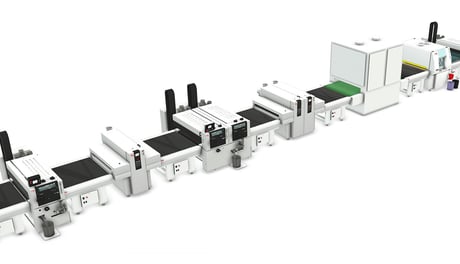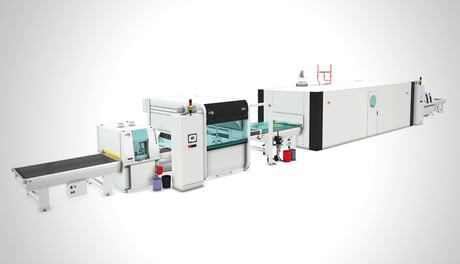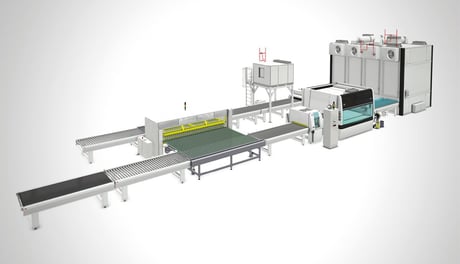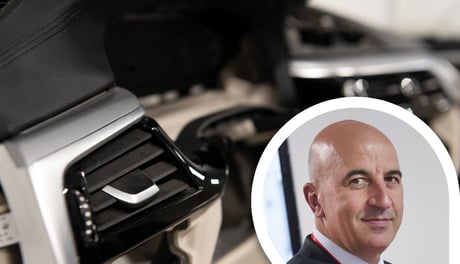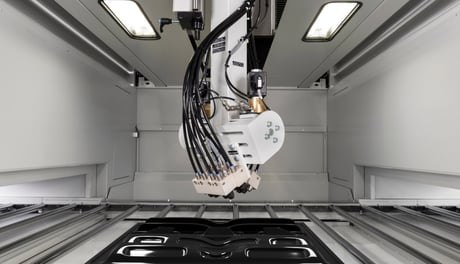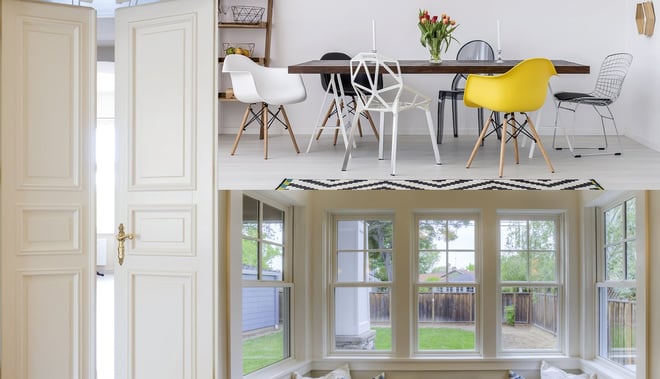
In a scenario of relentless evolution of the manufacturing industry, the use of advanced spray coating technologies is becoming a must, especially when it comes to manufacturing doors, windows and other 3D items.
We are referring, more specifically, to automatic techniques which do not only increase the productivity and profitability of finishing lines. They also ensure, for the companies that implement them, a leading position in terms of innovation and sustainability within their respective markets.
The greater system efficiency ensured by automatic spray coating results in other advantages including improved production quality and a significant reduction in waste. And there's more: the levels of performance control and worker safety that can be achieved thanks to real-time monitoring of the manufacturing processes and machinery condition were simply unthinkable until recently.
What is Spray Coating?
Spray coating is one of the most popular surface finishing techniques, particularly among manufacturers of window frames and exterior doors; this technique is also widely used by manufacturers of three-dimensional items (such as helmets, musical instruments and furnishing accessories).
According to this method, lacquer can be applied both manually and through the use of specific machines that work automatically.
When spray coating is carried out automatically, a few important distinctions should be made: the range of machinery currently available commercially varies significantly in terms of complexity and functionality. It includes plain or composite lines, flat lines, vertical lines, elliptical solutions as well as sophisticated spray coating robots which leverage specially designed software to guarantee top performance in any condition of use.
THE MOST INNOVATIVE FINISHING SOLUTIONS
Discover how highly advanced finishing solutions can sharpen your competitiveness.
Benefits of automated spray coating
Below is a review of spray coating techniques and, in particular, of the advantages they offer compared to traditional approaches. There are essentially five advantages guaranteed by these methods:
1) Improved efficiency and productivity
Automatic spray coating systems can first of all significantly increase production speed. By eliminating manually controlled steps, especially when it comes to changing the workpieces to process, these systems can coat multiple items at once, allowing manufacturers to meet tight deadlines and efficiently manage large-volume orders and small batches alike. The robotic arms featured by the most advanced automated systems also allow for consistent and repeatable results, minimising downtime and optimising the production line.
2) Improved quality and homogeneity
Another plus of automatic spray coating is the enhanced-quality, more homogeneous finish that can be obtained. Automatic systems apply even coats of lacquer, guaranteeing homogeneous thickness and coverage without the streaks or imperfections typical of manual techniques. This level of homogeneity is essential in the industries where product aesthetics and durability are key, such as door and window manufacturing.
The technology underlying automatic processes allows for precise control of parameters such as spray range, angle and pressure, which allows for superior results and reduces the number of rejects, i.e. items that fail quality checks.
3) Waste reduction and cost efficiency
In traditional hand coating applications, a significant amount of lacquer can be wasted due to overspray and uneven application. Automatic spray coating systems are instead designed to minimise material losses - which in turn reduces overall production costs.
4) Greater compliance with environmental regulations
Most modern spray coating machines have built-in systems to reduce emissions of volatile organic compounds and filtration systems that capture overspray and recycle unused paint. These features not only help manufacturers ensure that their production processes comply with environmental regulations, but also improve the company's brand positioning among sustainability-conscious consumers.
5) Optimal safety and ergonomics
Last but not least, safety and ergonomics play a key role in the workplace. Traditionally, manual coating often exposes workers to hazardous materials, noxious fumes, and in some cases, to the risk of repetitive strain injuries. Automated spray coating systems, on the other hand, reduce direct worker exposure to potentially harmful substances by minimising physical actions throughout the finishing process.
Main spray coating applications
Thanks to automation, modern spray coating solutions are able to handle a wide range of materials and finishes.
The machines are extremely versatile and, as mentioned, can be integrated into dedicated lines for the production of a number of three-dimensional items, from wooden doors to windows and window frames, panels and furnishing accessories.
This is all thanks to easily programmable systems, whose modules are suitable for different types of lacquer, colours and finishes. This allows manufacturers to streamline all their processes, including those that require extensive customisation, and to quickly respond to different types of order (without having to resort to total line reconfiguration). It is precisely this degree of flexibility that helps companies stay competitive in a market characterised by ever-changing trends.
The following are a few Case Studies regarding companies that have successfully used the most innovative spray coating techniques:
- Tucson focuses on automation to combine economies of scale with customisation
- WIP Industries goes for automation and boosts productivity
- No more machine downtime for Pianca thanks to automatic colour changeover
Spray coating, a solution for every need
There are several lines of machinery and of hardware and software architectures that allow vertical solutions to be built - able to meet the needs of specific fields of use. Automating spray coating processes in order to maximise investments essentially means choosing the right combinations, integrating different approaches according to the type of result required.
We at Cefla Finishing know this well and this is why we have developed a complete and modular range, with specialised and complementary functions that can be integrated to implement virtually any type of finishing line. The main line types are listed below.
Overhead lines
Simplifying the spray coating process is one of the main requirements of manufacturers interested in automating their operations. In this respect, overhead lines are the ideal solution for market players whose primary objective is to manage large production volumes while maintaining the right level of flexibility: only in this way can specific requests be met in terms of the type of substrate to be used and the requirements to be fulfilled by the end products. Overhead lines are in fact characterised by a high level of control over the finishing process, thanks to the use of limited amounts of lacquer and to precise movements performed to obtain a homogeneous finish even on three-dimensional surfaces with complex shapes.
Ground level lines
Spray coating robots applied to ground lines allow products to be coated as they are fed on - supported by a tray or workpiece holder. This process leads directly to the next process step i.e. drying.
This approach to spray coating automation delivers a better finish and higher quality end products, while ensuring greater production efficiency and shorter lead times. The reduced lacquer consumption goes hand in hand with the minimised use of manpower for coating and handling operations, which results in significant savings as early as in the medium term.
Anthropomorphic robots
The anthropomorphic spraying robots work at constant speed while ensuring an exact distance between the gun and the workpiece. In this way they optimise the consumption and homogeneity of the applied lacquer coating. Cefla created its own anthropomorphic robot iGiotto, a complete coating system for water or solvent-based lacquers, which can be integrated with appropriate software to manage every aspect of the spraying process.
Automation Software
Finally, the most advanced automatic spray coating systems are equipped with data collection and analysis tools. These solutions provide insights into production efficiency, paint consumption and overall process performance, enabling manufacturers to make informed decisions based on real-time data. However, the software analytical capabilities don't stop there: they enable continuous process improvement resulting in more careful resource allocation and better cost management over time.
THE MOST INNOVATIVE FINISHING SOLUTIONS
Discover how highly advanced finishing solutions can sharpen your competitiveness.

